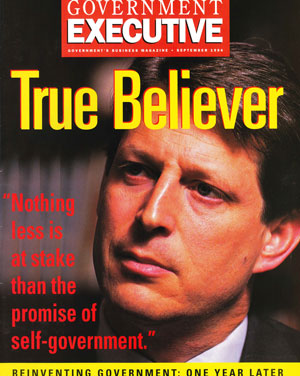
OPM Needs a Mission—Not a Funeral
What we were saying 20 years ago about human resources management.
From the archives of Government Executive…
September 1994—The death knell has sounded, and the long knives are dripping blood. The only question that seems to remain is, “When is the funeral?”
That’s what the pundits are saying about the Office of Personnel Management, the much-maligned arbiter of the rules and regulations on the hiring, firing and retiring of federal workers. Although it stopped far short of calling for OPM’s demise, Vice President Gore’s National Performance Review report painted a picture of an agency pitiably adrift, flailing about “to find its identity.” The NPR has strongly recommended a complete cultural overhaul of the place, while seriously doubting the agency’s ability to pull off such a transformation.
More recently, in these pages, columnist Paul Light cited OPM’s dwindling resources and organizational confusion in proposing what appears to many to be the logical next step: abolishing OPM and dispersing its essential functions—retirement and insurance processing, Title 5 compliance checking, centralized job information, etc.—to other agencies. (See “Management Focus,” March 1994.)

OPM’s identity crisis began when the agency was established in 1979 with a strangely mixed bag of missions that confused client agencies and OPM itself.
One the one hand, OPM was charged with setting personnel policy for all agencies covered under Title 5 and with making sure the rules were being followed; these “central control” functions were (and still are) supported by appropriated funds.
On the other hand, OPM has always had a service function that has nothing to do with its policy/oversight role. Activities such as doing background investigations, providing training and conducting research projects are done under contract with other agencies, which reimburse OPM through payments into a revolving fund. Demand for these services has been shrinking, with the result that OPM this year has been forced to lay off more than 700 people.
Public organizations that try to simultaneously perform dual roles of control and service simply never work well. A number of recent studies—see Michael Barzelay’s Breaking Through Bureaucracy (University of California Press, 1992) and my own article, “The Service Marketplace,” in the spring 1993 issue of The Public Manager —have documented the importance of separating customer-focused service functions from those that are rule-based. The mind-sets are fundamentally divergent, if not contradictory, and to allow them to exist side by side often results in confused strategy, wasted resources, energy-sapping conflicts and diffused accountability.
The fact that OPM has had dual missions throughout its history is at the core of its problem. Could the Office of Management and Budget or the General Accounting Office be expected to perform their oversight and control functions if they were also required to try to sell their expertise to the very same federal agencies they were reviewing and evaluating? This is precisely what Congress has allowed to continue for far too long at OPM.
The agency itself has been exacerbating the problem in recent months by thrusting its very talented policy-setting and oversight staffs into an ill-defined entrepreneurial mode without clearly redefining fundamental roles and responsibilities. Attempting to charge agencies for OPM’s statutorily based functions of policy and oversight raises legal and ethical problems, which the agency is choosing to ignore.
After serving seven years as a senior executive at OPM, ending when I retired last March, I have concluded that there is a middle ground between those who are calling for the funeral cortege to begin and those who are saying “hands off OPM.”
It is clear that the agency cannot be abolished now; federal workers are far too valuable an asset to leave untended, without central strategic management. Congress is not yet ready for so dramatic a step, nor would it palatable to cede OPM’s core policymaking and oversight roles to OMB. Does anyone really think that OMB, having virtually abdicated its “M” function, would suddenly take the leadership responsibility for a “soft” area like personnel management seriously?
Yet it would also be foolhardy to simply allow OPM to attenuate indefinitely in its current form. Instead, the Administration and Congress must quickly decide what they want OPM to be: credible policy maker/adviser/evaluator, or entrepreneurial purveyor of human resource management services. Both roles are valid and valuable, but they must not be allowed to co-exist in a single agency.
The first role provides a locus of accountability for the governmentwide personnel management system, something Congress is not likely to jettison soon. Indeed, this function will have to remain in the government somewhere, whether in a smaller OPM or in a broader agency akin to the “Office of Federal Management” that some say should be created.
The second role offers large cost efficiencies that flow from the economies of scale that a central service provided can yield. The “business” operations of OPM could be reconstituted as a quasi-commercial organization (perhaps a public corporation) offering human resource management services to the agencies on a pay-as-you-go basis and funded solely in that manner, as has happened in Australia and New Zealand.
Whichever mission is chosen for the agency, a strategically realigned, mission-directed OPM would have a chance to succeed—much smaller probably, but with a real sense of purpose. The time has come to make a choice. Otherwise, we will be left with an agency leading what the existentialists call a kind of “death-in-life”—breathing perhaps, but not thriving; moving about, but not in any particular direction. This kind of agency deserves to be cut off from life-support systems in preparation for a long-overdue burial.
In 1994, Bob Agresta was a senior associate with RJA Associates, a human resource development research and consulting firm based in New York.
NEXT STORY: A Pugnacious Obama Takes on (Most of) the World






